Duiker William J., Spielvogel Jackson J. The Essential World History
Подождите немного. Документ загружается.


was reduced. A period of euphoria erupted that came to
be known as the ‘‘Prague Spring.’’
It proved to be short-lived. Encouraged by Dubc
ˇ
ek’s
actions, some Czechs called for more far-reaching re-
forms, including neutrality and withdrawal from the
Soviet bloc. To forestall the spread of this ‘‘spring fever,’’
the Soviet Red Army, supported by troops from other
Warsaw Pact states, invaded Czechoslovakia in August
1968 and crushed the reform movement. Gustav Hus
ak
(1913--1991), a committed Stalinist, replaced Dubc
ˇ
ek and
restored the old order, while Moscow attempted to justify
its action by issuing the so-called Brezhnev Doctrine (see
the box above).
In East Germany as well, Stalinist policies continued
to hold sway. The ruling Communist government in East
Germany, led by Walter Ulbricht, had consolidated its
position in the early 1950s and became a faithful Soviet
satellite. Industry was nationalized and agriculture col-
lectivized. After the 1953 workers’ revolt was crushed
by Soviet tanks, a steady flight of East Germans to West
Germany ensued, primarily through the city of Berlin.
This exodus of mostly skilled laborers (‘‘Soon only party
chief Ulbricht will be left,’’ remarked one Soviet observer
sardonically) created economic problems and in 1961 led
the East German government to erect a wall separating
East Berlin from West Berlin, as well as even more fear-
some barriers along the entire border with West Germany.
After building the Berlin Wall, East Germany suc-
ceeded in developing the strongest economy among the
Soviet Union’s Eastern European satellites. In 1971, Ul-
bricht was succeeded by Erich Honecker (1912--1994), a
party hard-liner. Propaganda increased, and the use of the
Stasi, the secret police, became a hallmark of Honecker’s
virtual dictatorship. Honecker ruled unchallenged for the
next eighteen years.
An Era of D
etente
Still, under Brezhnev and Kosygin, the Soviet Union
continued to pursue peaceful coexistence with the West
THE BREZHNEV DOCTRINE
In the summer of 1968, when the new Communist
Party leaders in Czechoslovakia were seriously con-
sidering proposals for reforming the totalitarian
system there, the Warsaw Pact nations met under
the leadership of Soviet party chief Leonid Brezhnev to assess
the threat to the socialist camp. Shortly after, military forces of
several Soviet bloc nations entered Czechoslovakia and im-
posed a new government subservient to Moscow. The move
was justified by the spirit of ‘‘proletarian internationalism’’ and
was widely viewed as a warning to China and other socialist
states not to stray too far from Marxist-Leninist orthodoxy, as
interpreted by the Soviet Union. But Moscow’s actions also
raised tensions in the Cold War.
A Letter to the Central Committee of the Communist
Party of Czechoslovakia
Dear comrades!
On behalf of the Central Committees of the Communist and Workers’
Parties of Bulgaria, Hungary, the German Democratic Republic, Po-
land, and the Soviet U nion, we address ourselves to you with this let-
ter, prompted by a feeling of sincere friendship based on the principles
of Marxism-Leninism and proletarian internationalism and by the
concern of our common affairs for strengthening the positions of
socialism and the security of the socialist community of nations.
The development of events in your country evokes in us deep
anxiety . It is our firm conviction that the offensive of the reactionary
forces, backed by imperialists, against your Party and the foundations
of the social system in the Czechoslovak Socialist Republic, threatens
to push your country off the road of socialism and that consequently
it jeopardizes the interests of the entire socialist system. ...
We neither had nor have any intention of interfering in such
affairs as are strictly the internal business of your Party and your state,
nor of violating the principles of respect, independence, and equality in
the relations among the Communist P arties and socialist countries. ...
At the same time we cannot agr ee to have hostile forc es push
your country from the road of socialism and create a threat of severing
Czechoslovakia from the socialist community. ... This is the common
cause of our countries, which have joined in the Warsaw Treaty to en-
sure independence, peace, and security in Europe, and to set up an in-
surmountable barrier against the intrigues of the imperialist forces,
against aggression and revenge. ... We shall never agree to have impe-
rialism, using peaceful or nonpeaceful methods, making a gap from
the inside or from the outside in the socialist system, and changing in
imperialism’s favor the correlation of forces in Europe. ...
That is why we believe that a decisive rebuff of the anti-Communist
forces, and decisive efforts for the preservation of the socialist system in
Czechoslovakia are not only your task but ours as well. ...
We express the conviction that the Communist Party of Czecho-
slovakia, conscious of its responsibility, will take the necessary steps to
block the path of reaction. In this struggle you can count on the soli-
darity and all-round assistance of the fraternal socialist countries.
Warsaw, July 15, 1968.
Q
How did Leonid Brezhnev justify the Soviet decision to
invade Czechoslovakia? To what degree do you find his argu-
ments persuasive?
664 CHAPTER 26 EAST AND WEST IN THE GRIP OF THE COLD WAR

and adopted a generally cautious posture in foreign affairs.
By the early 1970s, a new age in Soviet-American relations
had emerged, often referred to by the French term d
etente,
meaning a reduction of tensions between the two sides.
One symbol of d
etente was the Anti-Ballistic Missile
(ABM) Treaty, often called SALT I (for Strategic Arms
Limitation Talks), signed in 1972, in which the two na-
tions agreed to limit the size of their ABM systems.
Washington’s objective in pursuing the treaty was to
make it unlikely that either superpower could win a nu-
clear exchange by launching a preemptive strike against
the other. U.S. officials believed that a policy of ‘‘equiva-
lence,’’ in which the two sides had roughly equal power,
was the best way to avoid a nuclear confrontation. D
etente
was pursued in other ways as well. When President Nixon
took office in 1969, he sought to increase trade and cul-
tural contacts with the Soviet Union. His purpose was to
set up a series of ‘‘linkages’’ in U.S.-Soviet relations that
would persuade Moscow of the economic and social
benefits of maintaining good relations with the West.
A symbol of that new relationship was the Helsinki
Accords. Signed in 1975 by the United States, Canada,
and all European nations on both sides of the iron
curtain, these accords recognized all borders in Europe
that had been established since the end of World War II,
thereby formally acknowledging for the first time the
Soviet sphere of influence in Eastern Europe. The Hel-
sinki Accords also committed the signatories to recognize
and protect the human rights of their citizens, a clear
effort by the Western states to improve the performance
of the Soviet Union and its allies in that arena.
Renewed Tensions in the Third World
Protection of human rights became one of the major
foreign policy goals of the next U.S. president, Jimmy
Carter (b. 1924). Ironically, just at the point when U .S.
inv olvement in Vietnam came to an end and relations with
China began to improve, U .S.-So viet relations began to
sour, for several reasons. Some Americans had become
increasingly concerned about aggressive new tendencies in
Soviet foreign policy. The first indication came in
Africa. Soviet influenc e was on the rise in Somalia, across
the Red Sea from South Yemen, and later in neighboring
Ethiopia. In Angola, once a colony of Portugal, an insur-
gent movement supported by C uban troops came to
power. In 1979, Soviet tr oops wer e sent across the border
into Afghanistan to protect a newly installed Marxist re-
gime facing internal resistanc e from fundamentalist Mus-
lims. Some observers suspected that the ultimate objective
of the Soviet advance into hitherto neutral Afghanistan was
to extend Soviet power into the oil fields of the Persian
Gulf. To deter such a possibility, the White House
promulgated the Carter Doctrine, which stated that the
U nited States would use its military po wer, if necessary, to
safeguard Western access to the oil r eserves in the Middle
East. In fact, sources in Mosco w later disclosed that the
Soviet advance had little to do with the oil of the P ersian
Gulf but was an effort to incr ease Soviet influence in a
region increasingly beset by Islamic fervor. Soviet officials
feared that Islamic activism could spread to the Muslim
populations in the Soviet republics in Central Asia and
were confident that the United States was too distracted by
the ‘‘Vietnam syndrome’’ (the public fear of U.S. in-
volvement in another Vietnam-type conflict) to respond.
Another reason for the growing suspicion of the
Soviet Union in the United States was that some U.S.
defense analysts began to charge that the Soviet Union
had rejected the policy of equivalence and was seeking
strategic superiority in nuclear weapons. Accordingly,
they argued for a substantial increase in U.S. defense
spending. Such charges, combined with evidence of So-
viet efforts in Africa and the Middle East and reports
of the persecution of Jews and dissidents in the Soviet
U nion, helped undermine public support for d
etente in the
United States. These changing attitudes were reflected in
the failure of the Carter administration to obtain con-
gressional approval of a new arms limitation agreement
(SALT II), signed with the Soviet Union in 1979.
Countering the Evil Empire
The early y ears of the administration of Pr esident R onald
Reagan (1911--2004) witnessed a return to the harsh
CHRONOLOGY
The Cold War to 1980
Truman Doctrine 1947
Formation of NATO 1949
Soviet Union explodes first nuclear device 1949
Communists come to power in China 1949
Nationalist government retreats to Taiwan 1949
Korean War 1950--1953
Geneva Conference ends Indochina War 1954
Warsaw Pact created 1955
Khrushchev calls for peaceful coexistence 1956
Sino-Soviet dispute breaks into the open 1961
Cuban Missile Crisis 1962
SALT I treaty signed 1972
Nixon’s visit to China 1972
Fall of South Vietnam 1975
Soviet invasion of Afghanistan 1979
A
N ERA OF EQUIVALENCE 665
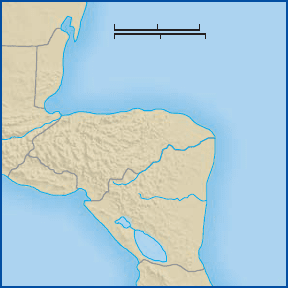
rhetoric, if not all of the harsh practices, of the Cold War.
President Reagan’s anti-Communist credentials were well
known. In a speech given shortly after his election in
1980, he referred to the Soviet Union as an ‘‘evil empire’’
and frequently voiced his suspicion of Soviet motives in
foreign affairs. In an effort to eliminate perceived Soviet
advantages in strategic weaponry, the White House began
a military buildup that stimulated a renewed arms race.
In 1982, the Reagan administration introduced the nu-
clear-tipped cruise missile, whose ability to fly at low
altitudes made it difficult to detect by enemy radar.
Reagan also became an ardent exponent of the Strategic
Defense Initiative (SDI), nicknamed ‘‘Star Wars.’’ The
intent behind this proposed defense system was not only
to create a space shield that could destroy incoming
missiles but also to force Moscow into an arms race that it
could not hope to win.
The Reagan administration also adopted a more ac-
tivist, if not confrontational, stance in the Third World.
That attitude was most directly dem-
onstrated in Central America, where the
revolutionary Sandinista regime had
been established in Nicaragua after the
overthrow of the Somoza dictatorship
in 1979. Charging that the Sandinista
regime was supporting a guerrilla in-
surgency movement in nearby El Sal-
vador, the Reagan administration began
to provide material aid to the govern-
ment in El Salvador while simulta-
neously supporting an anti-Communist
guerrilla movement (the Contras)in
Nicaragua. Though the administration
insisted that it was countering the
spread of communism in the Western Hemisphere, its
Central American policy aroused considerable controversy
in Congress, where some members charged that growing
U.S. involvement could lead to a repeat of the nation’s
bitter experience in Vietnam.
The Reagan administration also took the offensive in
other areas. By providing military support to the anti-
Soviet insurgents in Afghanistan, the White House helped
maintain a Vietnam-like war in Afghanistan that en-
tangled the Soviet Union in its own quagmire. Like the
Vietnam War, the conflict in Afghanistan resulted in
heavy casualties and demonstrated that the influence of a
superpower was limited in the face of strong nationalist,
guerrilla-type opposition.
Toward a New World Order
In 1985, Mikhail Gorbachev was elected secretary of
the Communist Par t y of the Soviet Union. During
Bre zhnev’s last year s and the brief tenures o f hi s two
successors (see Chapter 27), the Soviet Union had en-
tered an era of serious economic decline, and the dy-
namic new par ty chief was well aware that drastic
changes would be needed to rekindle the dreams that
had inspired the Bolshev ik Revolution. During the next
few years, he launched a program of restructuring
(perestroika) to revitalize the Soviet system. As part of
th at program, h e set out to improve re lations with the
United States and the res t of the capitalist world. When
he met with President Reag an in Reyk javik, the capital
of Iceland, the two leaders agreed to set aside their
ideological differences.
Gorbachev’s desperate effort to rescue the Soviet U n-
ion from collapse was too little and too late. As 1991 drew
to a close, the Soviet U nion, so long an apparently per-
manent fixture on the global scene, suddenly disintegrated;
in its place ar ose fifteen new nations. That same year, the
string of Soviet satellites in Eastern Europe broke loose
from Moscow’s grip and declared their
independence from Communist rule.
The Cold War was over.
The end of the Cold War lulled
many observers into the seductive
vision of a new world order that
would be c haracterized by peaceful
cooperation and increasing prosper-
ity. Sadly, such hopes have not been
realized (see the comparative essay
‘‘Global Village or Clash of Civi-
lizations?’’ on p. 667). A bitter civil
war in the Balkans in the mid-1990s
graphically demonstrated that old
fault lines of national and ethnic
hostility still divided the post--Cold War world. Else-
where, bloody ethnic and religious disputes broke out
in Africa and the Middle East. Then, on September 11,
2001, the world entered a dangerous new era when
terrorists attacked the nerve centers of U.S. power in
New York City and Washington, D.C., inaugurating a
new round of tension between the West and the forces
of militant Islam. These events will be discussed in
greater detail in the chapters that follow.
In the meantime, other issues beyond the headlines
clamor for attention. Environmental problems and the
threat of global warming, the growing gap between rich
and poor nations, and tensions caused by migrations
of peoples all present a growing threat to political
stability and the pursuit of happiness. As the twenty-
first centur y progresses, the task of guaranteeing the
survival of the human race appears to be just as chal-
lenging, and even more complex, than it was during
the Cold War.
MEXICO
EL
SALVADOR
NICARAGUA
COSTA RICA
HONDURAS
BELIZE
Pacific
Ocean
Caribbean Sea
G
U
A
T
E
M
A
L
A
200 Miles
300 Kilometers0
0
Northern Central America
666 CHAPTER 26 EAST AND WEST IN THE GRIP OF THE COLD WAR

COMPARATIVE ESSAY
G
LOBAL VILLAGE OR CLASH OF CIVILIZATIONS?
As the Cold War came to an end in 1991, states-
men, scholars, and political pundits began to fore-
cast the emergence of a ‘‘new world order.’’ One
hypothesis was that the decline of communism sig-
naled that the industrial capitalist democracies of the West had
triumphed in the world of ideas and were now poised to remake
the rest of the world in their own image.
Not all agreed with this optimistic view of the world situation. In
The Clash of Civilizations and the Remaking of the World Order, the
historian Samuel P. Huntington suggested that the post--Cold War era,
far from marking the triumph of Western ideals, would be character-
ized by increased global fragmentation and a ‘‘clash of civilizations’’
based on ethnic, cultural, or religious differences. According to Hun-
tington, the twenty-first century would be dominated by disputatious
cultural blocs in East Asia, Western Europe and the United States,
Eurasia, and the Middle East. The dream of a universal order---a global
village---dominated by Western values, he concluded, is a fantasy.
Recent events have lent some support to Huntington’s hypothe-
sis. The collapse of the Soviet Union led to the emergence of an at-
mosphere of conflict and tension all along the perimeter of the old
Soviet Empire. More recently, the terrorist attack on the United
States in September 2001 set the advanced nations of the West and
much of the Muslim world on a collision course. As for the new
economic order---now enshrined as official policy in Western
capitals---public anger at the impact of globalization and the recent
worldwide financial crisis has reached disturbing levels in many
countries, leading to a growing demand for self-protection and
group identity in an impersonal and rapidly changing world.
Are we then headed toward Huntington’s prediction of multiple
power blocs divided by religion and culture? His thesis is indeed a
useful corrective to the complacent tendency of many observers to
view Western civilization as the zenith of human achievement. On the
other hand, by dividing the world into competing cultural blocs,
Huntington has underestimated the centrifugal forces at work in the
various regions of the world. As the industrial and technological revo-
lutions spread across the face of the earth, their impact is measurably
stronger in some societies than in others, thus intensifying historical
rivalries in a given region while establishing links between individual
societies and counterparts in other parts of the world. In recent years,
for example, Japan has had more in common with the United States
than with its traditional neighbors, China and Korea.
The most likely scenario for the next few decades, then, is more
complex than either the global village hypothesis or its rival, the clash
of civilizations. The twenty-first century will be characterized by si-
multaneous trends toward globalization and fragmentation as the
thrust of technology and information transforms societies and gives
rise to counterreactions among societies seeking to preserve a group
identity and sense of meaning and purpose in a confusing world.
Q
In the next decade, do you believe that the forces of
globalization or of fragmentation will be the stronger?
Ronald McDonald in Indonesia. This giant statue welcomes young
Indonesians to a McDonald’s restaurant in Jakarta, the capital city. McDonald’s
food chain symbolizes the globaliza tion of today’s world civilization.
CONCLUSION
AT THE END OF WORLD WAR II, a new conflict appeared in
Eur ope as the two superpowers, the U nited States and the Soviet U nion,
began to compete for political domination. This ideological division soon
spread to the rest of the world as the U nited States fought in Korea and
Vietnam to prevent the spread of communism, promoted by the new
Maoist government in China, while the Soviet Union used its influence to
prop up pro-Soviet regimes in Asia, Africa, and Latin America.
What had begun, then, as a confrontation across the great divide
of the ‘‘iron curtain’’ in Europe eventually took on global significance,
much as the major European powers had jostled for position and
advantage in Africa and eastern Asia prior to World War I. As a result,
both Mosc ow and Washington became entangled in areas that in
themselves had little importance in terms of real national security
interests.
As the twentieth century entered its last two decades, however,
there were tantalizing signs of a thaw in the Cold War. In 1979,
China and the United States decided to establish mutual diplomatic
relations, a consequence of Beijing’s decision to focus on domestic
CONCLUSION 667
c
William J. Duiker
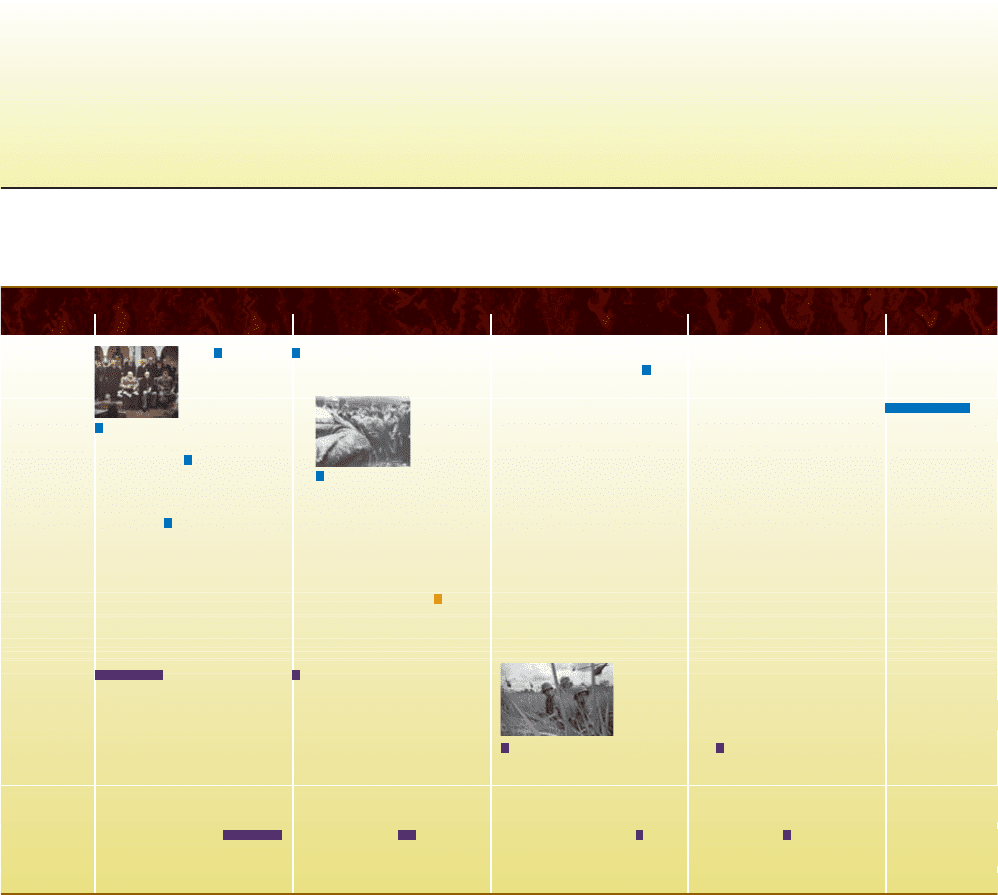
SUGGESTED READING
Cold War Literature on the Cold War is abundant. Two
general accounts are R. B. Levering, The Cold War, 1945--1972
(Arlington Heights, Ill., 1982), and B. A. Weisberger, Cold War,
Cold Peace: The United States and Russia Since 1945 (New York,
1984). Two works that maintain that the Soviet Union was chiefly
responsible for the Cold War are H. Feis, From Trust to Terror: The
Onset of the Cold War, 1945--1950 (New York, 1970), and A. Ulam,
The Rivals: America and Russia Since World War II (New York,
1971). Revisionist studies on the Cold War have emphasized U.S.
responsibility for the Cold War, especially its global aspects. These
works include J. Kolko and G. Kolko, The Limits of Power: The
World and United States Foreign Policy, 1945--1954 (New York,
1972); W. La Feber, America, Russia, and the Cold War, 1945--
1966, 8th ed. (New York, 2002); and M. Sherwin, A World
Destroyed: The Atomic Bomb and the Grand Alliance (New York,
1975). For a highly competent retrospective analysis of the Cold War
era, see J. L. Gaddis, We Now Know: Rethinking Cold War History
(Oxford, 1997). Also see his more general work The Cold War: A
New History (New York, 2005). For the perspective of a veteran
journalist, see M. Frankel, High Noon in the Cold War: Kennedy,
Khrushchev, and the Cuban Missile Crisis (New York, 2004).
A number of studies of the early stages of the Cold War have
been based on documents unavailable until the late 1980s or early
1990s. See, for example, O. A. Westad, Cold War and Revolution:
Soviet-American Rivalry and the Origins of the Chinese Civil War
reform and stop supporting wars of national liberation in Asia. Six
years later, the ascent of Mikhail Gorbachev to leadership in the
Soviet Union, culminating in the collapse of the Soviet Union in
1991, brought a final end to almost half a century of bitter rivalry
between the world’s two superpowers.
The Cold War thus ended without the horrifying vision of a
mushroom cloud. Unlike the earlier rivalries that had resulted in two
world wars, this time the antagonists had gradually come to real ize
that the struggle for supremacy could be carried out in the political
and economic arena rather than on the battlefield. And in the final
analysis, it was not military superiority, but political, economic, and
cultural factors that brought about the triumph of Western civilization
over the Marxist vision of a classless utopia. The world’s statesmen
could now shift their focus to other problems of mutual conc ern.
TIMELINE
1945
1955 1965 1975 1985
Europe
Central
America
Asia
Yalta
Conference
Tito expelled from
Soviet bloc
Civil war in China Geneva Conference
ends conflict in Indochina
Communists seize
power in South Vietnam
United States sends
combat troops to
Vietnam
Sino-Soviet dispute begins Nixon visit to China
Marshall Plan
NATO
formed
Warsaw Pact created
Cuban Missile Crisis
SALT I pact signed
Perestroika
launched in
Soviet Union
Soviet invasion
of Afghanistan
Hungarian Revolution
Korean War
668 CHAPTER 26 EAST AND WEST IN THE GRIP OF THE COLD WAR
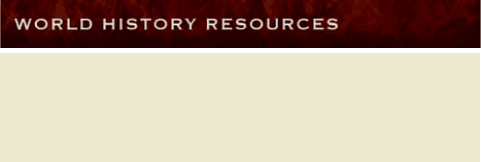
(New York, 1993); D. A. Mayers, Cracking the Monolith: U.S.
Policy Against the Sino-Soviet Alliance, 1949--1955 (Baton Rouge,
La., 1986); and Chen Jian, China’s Road to the Korean War: The
Making of the Sino-American Confrontation (New York, 1994). S.
Goncharov, J. W. Lewis, and Xue Litai, Uncertain Partners: Stalin,
Mao, and the Korean War (Stanford, Calif., 1993), provides a
fascinating view of the war from several perspectives.
For important studies of Soviet foreign policy, see A. B. Ulam,
Dangerous Relations: The Soviet Union in World Politics, 1970--1982
(New York, 1983). The effects of the Cold War on German y are
examined in J. H. Backer , The Decision to Divide Germany: American
For eign Policy in Transition (Durham, N.C., 1978). On atomic
diplomacy in the Cold War , see G. F. Herken, The Winning Weapon:
The Atomic Bomb in the Cold War, 1945--1950 (New York, 1981). For
a good intr oduction to the arms race, see E. M. Bottome, The Balance
of Terror: A Guide to the A rms Race, rev. ed. (Boston, 1986).
China There are several informative surveys of Chinese foreign
policy since the Communist rise to power. A particularly insightful
account is Chen Jian, Mao’s China and the Cold War (Chapel Hill,
N.C., 2001). On Sino-U.S. relations, see H. Harding, A Fragile
Relationship: The United States and China Since 1972 (Washington,
D .C., 1992), and W. Burr, ed., The Kissinger Transcripts: The Top-
Secret Talks with Beijing and Moscow (New York, 1998). On Chinese
policy in Korea, see Shu Guang Zhang, Mao’s Military Romanticism:
China and the Korean War (Lawrence, Kans., 2001), and Xiaobing
Li et al., Mao’s Generals Remember Korea (Lawrence, Kans., 2001).
On Sino-Vietnamese relations, see Ang Cheng Guan, Vietnamese
Communists’ Relations with China and the Second Indochina
Conflict (Jefferson, N.C., 1997).
Visit the website for The Essential World History to access study
aids such as Flashcards, Critical Thinking Exercises, and
Chapter Quizzes:
www.cengage.com/history/duikspiel/essentialworld6e
CONCLUSION 669
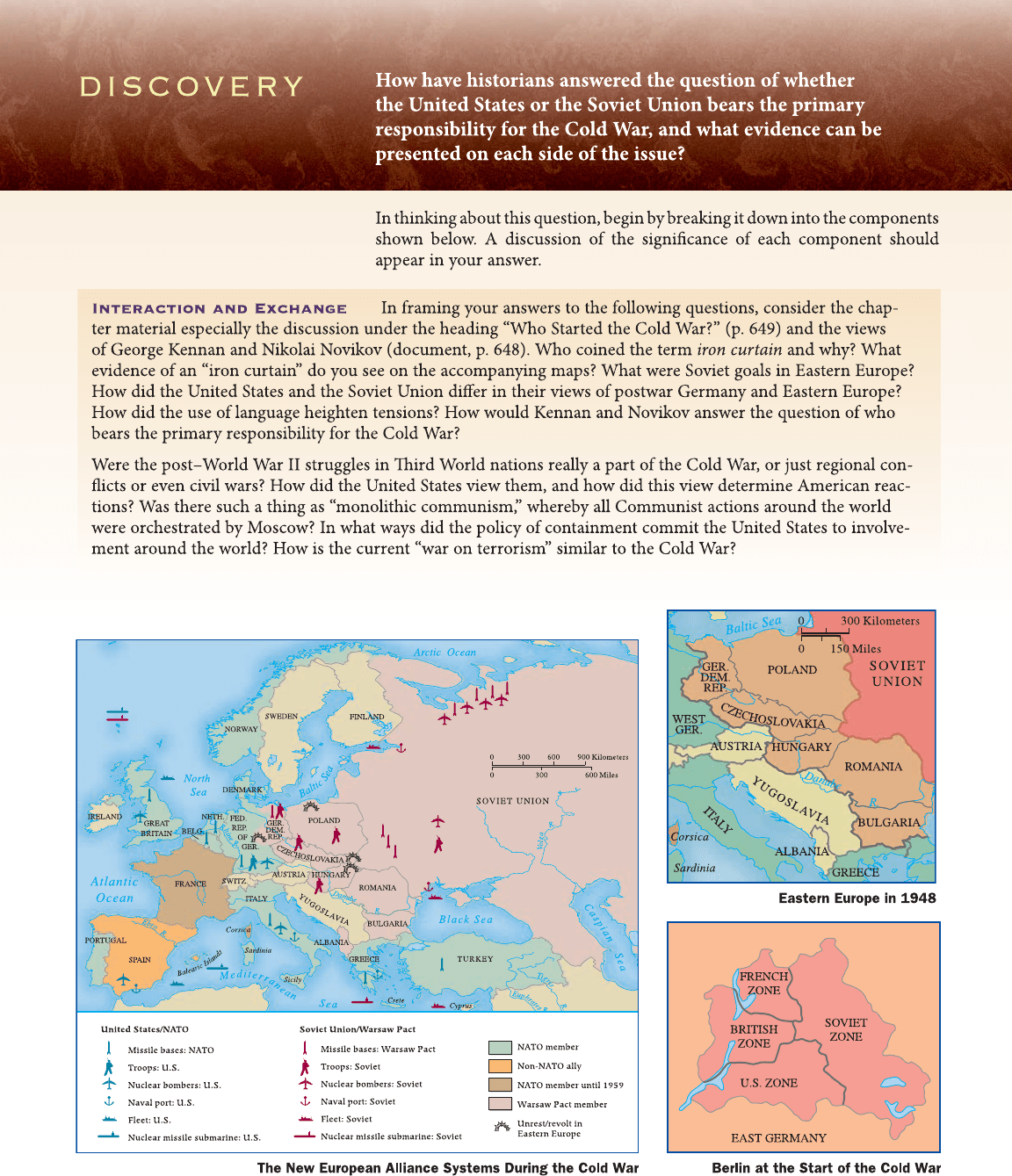
670
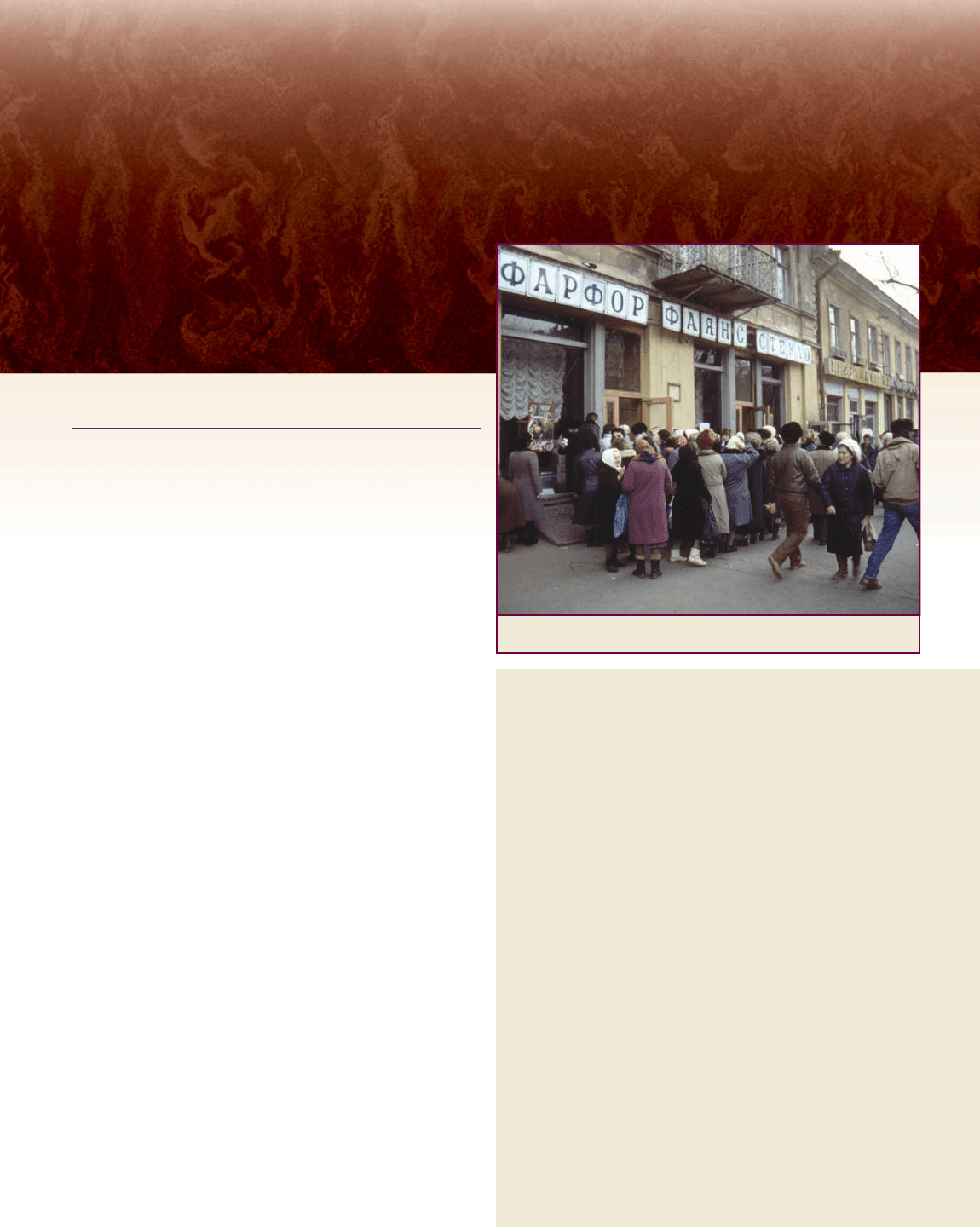
CHAPTER 27
BRAVE NEW WORLD: COMMUNISM ON TRIAL
CHAPTER OUTLINE
AND FOCUS QUESTIONS
The Postwar Soviet Union
Q
How did Nikita Khrushchev change the system that
the Soviet dictator Joseph Stalin had put in place before
his death in 1953? To what degree did his successors
continue Khrushchev’s policies?
The Disintegration of the Soviet Empire
Q
What were the key components of perestroika, which
Mikhail Gorbachev espouse d during the 1980s? Why
were they unsuccessful in preventing the collapse of the
Soviet Union?
The East Is Red: China Under Communism
Q
What were Mao Zedong’s chief goals for China, and
what policies did he inst itute to try to achieve them?
‘‘Serve the People’’: Chinese Society
Under Communism
Q
What significant political, economic, and social changes
have taken place in China since the death of Mao
Zedong? Have they been successful?
CRITICAL THINKING
Q
Why has communism survived in China when it failed
in Eastern Europe and Russia? Compare conditions in
China today with those in countries elsewhere in the
world that have abandoned the Communist system.
Are Chinese leaders justified in claiming that without
party leadership, the country would fall into chaos?
Shopping in Moscow
ACCORDING TO KARL MARX, capitalism is a system that
involves the exploitation of man by man; under socialism, it is the
other way around. That wry joke was typical of popular humor in
post--World War II Moscow, where the dreams of a future utopia
had faded in the grim reality of life in the Soviet Union.
For the average Soviet citizen after World War II, few images
better symbolized the shortcomings of the Soviet system than a long
line of people queuing up outside an official state store selling con-
sumer goods. Because the command economy was so inefficient,
items of daily use were chronically in such short supply that when a
particular item became available, people often lined up immediately
to buy several for themselves and their friends. Sometimes, when
people saw a line forming, they would automatically join the queue
without even knowing what item was available for purchase!
Despite the evident weaknesses of the centralized Soviet econ-
omy, the Communist monopoly on power seemed secure, as did
Moscow’s hold over its client states in Eastern Europe. In fact, for
three decades after the end of World War II, the Soviet Empire
appeared to be a permanent feature of the international landscape.
But by the early 1980s, it was clear that there were cracks in the
Kremlin wall. The Soviet economy was stagnant, the minority
nationalities were restive, and Eastern European leaders were
671
c
William J. Duiker

The Postwar Soviet Union
Q
Focus Questions: How did Nikita Khrushc hev change
the system that the Soviet dictator Joseph Stalin had
put in place before his death in 1953? To what degree
did his successors continue Khrushchev’s policies?
World War II had left the Soviet Union as one of the
world’s two superpowers and its leader, Joseph Stalin, in a
position of strength. He and his Soviet colleagues were
now in control of a vast empire that included Eastern
Europe, much of the Balkans, and new territory gained
from Japan in East Asia.
From Stalin to Khrushchev
At the same time, World War II had devastated the Soviet
Union. Nearly 30 million citizens lost their lives, and
cities such as Kiev, Kharkov, and Leningrad suffered
enormous physical destruction. As the lands that had
been occupied by the German forces were liberated, the
Soviet government turned its attention to restoring their
economic structures. Nevertheless, in 1945, agricultural
production was only 60 percent and steel output only
50 percent of prewar levels. The Soviet people faced in-
credibly difficult conditions: ill-housed and poorly
clothed, they worked longer hours and ate less they than
before the war.
Stalinism in Action In the immediate postwar years,
the Soviet Union removed goods and materials from
occupied Germany and extorted valuable raw materials
from its satellite states in Eastern Europe (see Map 27.1).
More important, however, to create a new industrial base,
Stalin returned to the method he had used in the 1930s---
the extraction of development capital from Soviet labor.
Working hard for little pay and for precious few con-
sumer goods, Soviet laborers were expected to produce
goods for export with little in return for themselves. The
incoming capital from abroad could then be used to
purchase machinery and Western technology. The loss of
millions of men in the war meant that much of this
tremendous workload fell upon Soviet women, who
performed almost 40 percent of the heavy manual labor.
The pace of economic recovery in the postwar Soviet
Union was impressive. By 1947, industrial production
had attained 1939 levels. New power plants, canals, and
giant factories were built, and industrial enterprises and
oil fields were established in Siberia and Soviet Central
Asia.
Although Stalin’s economic recovery policy was
successful in promoting growth in heavy industry, pri-
marily for the benefit of the military, consumer goods
remained scarce as long-suffering Soviet citizens were still
being asked to suffer for a better tomorrow. Heavy in-
dustry grew at a rate three times that of personal con-
sumption. Moreover, the housing shortage was acute,
with living conditions especially difficult in the over-
crowded cities.
When World War II ended in 1945, Stalin had been
in power for more than fifteen years. Political terror en-
forced by several hundred thousand secret police ensured
that he would remain in power. By the late 1940s, an
estimated nine million Soviet citizens were in Siberian
concentration camps.
Increasingly distrustful of competitors, Stalin ex-
ercised sole authority and pitted his subordinates against
each other. His morbid suspicions extended to even his
closest colleagues, causing his associates to become
completely cowed. As he remarked mockingly on one
occasion, ‘‘When I die, the imperialists will strangle all of
you like a litter of kittens.’’
1
The Rise and Fall of Khrushchev Stalin died---
presumably of natural causes---in 1953 and, after some
bitter infighting within the party leadership, was suc-
ceeded by Georgy Malenkov, a veteran administrator and
ambitious member of the Politburo (the party’s governing
body). But Malenkov’s reform goals did not necessarily
appeal to key groups, including the army, the Communist
Party, the managerial elite, and the security services (now
known as the Committee on Government Security, or
KGB). In 1953, Malenkov was removed from his position
as party leader, and by 1955 power had shifted to his rival,
the new party general secretary, Nikita Khrushchev.
672 CHAPTER 27 BRAVE NEW WORLD: COMMUNISM ON TRIAL
increasingly emboldened to test the waters of the global capitalist
marketplace. In the United States, the newly elected president,
Ronald Reagan, boldly predicted the imminent collapse of the
‘‘evil empire.’’
Within a period of less than three years (1989--1991), the
Soviet Union ceased to exist as a nation. Russia and other former
Soviet republics declared their separate independence, Communist
regimes in Eastern Europe were toppled, and the long-standing divi-
sion of postwar Europe came to an end. Although Communist par-
ties survived the demise of the system and showed signs of renewed
vigor in some countries in the region, their monopoly is gone, and
they must now compete with other parties for power.
The fate of communism in China has been quite different.
Despite some turbulence, communism has survived in China, even
as that nation takes giant strides toward becoming an economic su-
perpower. Yet, as China’s leaders struggle to bring the nation into
the twenty-first century, many of the essential principles of Marxist-
Leninist dogma have been tacitly abandoned.
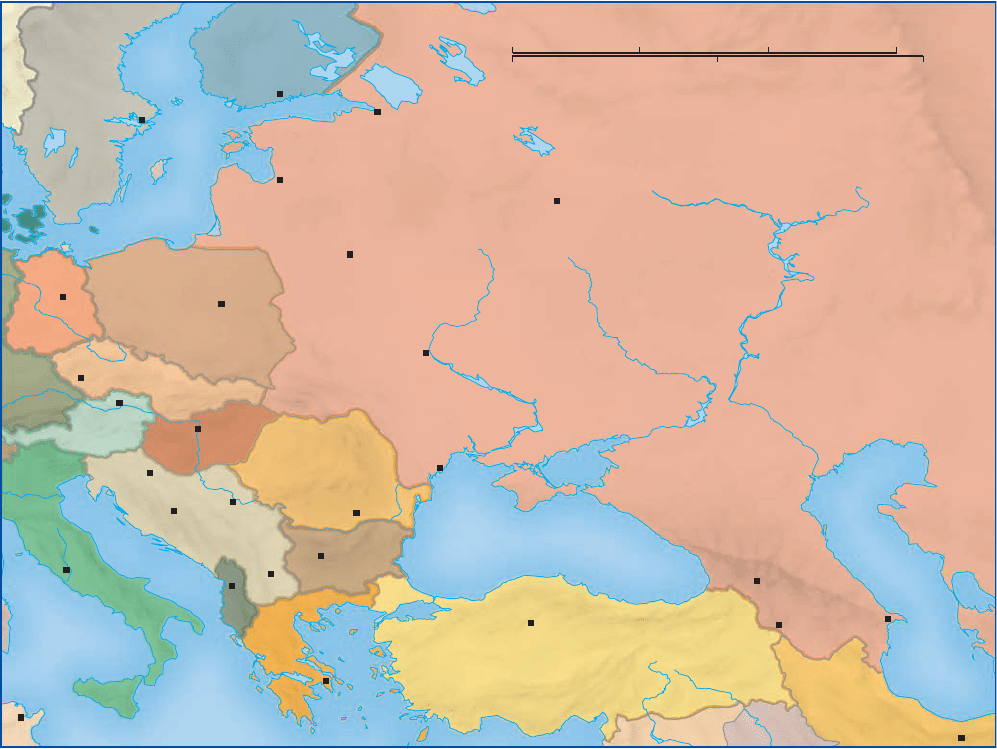
Once in power, Khrushchev moved vigorously to
boost the performance of the Soviet economy and revi-
talize Soviet society. In an attempt to release the stran-
glehold of the central bureaucracy over the national
economy, he abolished dozens of government ministries
and split up the party and government apparatus.
Khrushchev also attempted to rejuvenate the stagnant
agricultural sector. He attempted to spur production by
increasing profit incentives and opened ‘‘virgin lands’’ in
Soviet Kazakhstan to bring thousands of acres of new
land under cultivation.
An innovator by nature, Khrushchev had t o over-
come the inherently conservative instincts of the Soviet
bureaucracy, as well as those of the mass of the Sov iet
population. His plan to remove the ‘‘dead hand’’ of the
state, however laudable in intent, alienated much of the
Soviet official class, and his effort to split the party
angered those who saw it as the central force in the
Soviet system. Khrushchev’s agricultural schemes in-
spired similar opposition. His effort to persuade Rus-
sians to eat more corn (an idea he had apparently picked
up during a visit t o the United States) earned him the
mocking nickname ‘‘Cornman.’’ The i ndustrial growth
rate, which had soared in the early 1950s, now de clined
dramatically, from 13 percent in 1953 to 7.5 percent
in 1964.
Khrushchev was probably best known for his policy
of destalinization. Khrushchev had risen in the party
hierarchy as a Stalin prot
eg
e, but he had been deeply
disturbed by his mentor’s excesses and, once in a position
Bucharest
Tunis
Tehran
Ankara
Athens
Tirana
Belgrade
Sofia
Budapest
Tbilisi
Baku
Yerevan
Warsaw
Prague
Sarajevo
Skopje
Rome
Berlin
Stockholm
Helsinki
Moscow
Minsk
Odessa
Kiev
Vienna
Zagreb
Riga
Leningrad
ITALY
DENMARK
EAST
GERMANY
WEST
GER.
CZECHOSLOVAKIA
AUSTRIA
HUNGARY
ROMANIA
BULGARIA
SWEDEN
FINLAND
ALBANIA
GREECE
TURKEY
UNION OF SOVIET SOCIALIST REPUBLICS
YUGOSLAVIA
IRAN
POLAND
Sicily
Black Sea
D
n
i
e
p
e
r
R
.
V
o
l
g
a
R
.
B
a
l
t
i
c
S
e
a
Caspian Sea
D
a
n
u
b
e
R
.
T
i
g
r
i
s
R
.
E
u
p
h
r
a
t
e
s
D
o
n
R
.
0 500 1,000 Miles
0 500 750 1,500 Kilometers
MAP 27.1 Eastern Europe Under Soviet Rule. After World War II, the boundaries of
Eastern Europe were redrawn as a result of Allied agreements reached at the Tehran and Yalta
conferences. This map shows the new boundaries that were established throughout the region,
placing Soviet power at the center of Europe.
Q
How had the boundaries changed from the prewar era?
THE POSTWAR SOVIE T UNION 673
